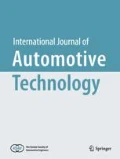Abstract
A junction block (or electrical distribution box) is electrical equipment that has been densely assembled from components such as buss bars, relays, and fuses to control the electric current flow in vehicles. Joule heat is generated in these parts as a result of electrical bulk resistance and electrical contact resistance. The generation of heat increases due to the complex behavior of modern vehicle electronic systems. Overheated parts can be damaged during operation due to thermal energy. The thermal assessment of a junction block is an important issue in automobile development. We suggest a methodology to simulate the transient temperature distribution of buss bars and electrical relays in a junction block. A finite element formulation of a coupled electro-thermal problem, which includes the effect of Joule heating, is introduced to the simulation. Finite element analysis (FEA) and experiments at the component level of buss bars and relays are conducted to investigate the thermal performance of a junction block. To verify the accuracy of the FEA procedure, the temperature history obtained by FEA is compared with the results obtained from experiments. The thermal-electric analysis of a typical junction block assembly is also discussed.
Similar content being viewed by others
References
André, J., Antoni, L., Petit, J. P., Vito, E. D. and Montani, A. (2009). Electrical contact resistance between stainless steel bipolar plate and carbon felt in PEFC: A comprehensive study. Int. J. Hydrogen Energy 34,7, 3125–3133.
ANSYS (2006). Documentation-Theory Manual. Release 10.0. ANSYS Inc.
Antonova, E. E. and Looman, D. L. (2005). Finite elements for thermoelectric device analysis in ANSYS. ICT 2005 24th Int. Conf. Thermoelectrics, 215–218.
Bartel, A. and Feldmann, U. (2006). Modeling and simulation for thermal-electric coupling in an SOIcircuit. Mathematics in Industry, 9, 27–32.
Bouranta, K., Maleginnakis, G. A. and Kroplin, B. (1998). Thermo-electric-mechanical coupling problems solved by FE-formulation. Engineering Computations 15,6, 804–828.
Carvou, E., Abdi, R. E., Razafiarivelo, J., Benjemaa, N. and Zindine, E. M. (2012). Thermo-mechanical study of a power connector. Measurement 45,5, 889–896.
Doerstling, B. H. (1998). Thermal-electrical modeling of electrical subsystems. SAE Paper No. 981111, 1–7.
Greenwood, J. A. (1966). Constriction resistance and real area of contact. British J. Applied Physics, 17, 1621–1632.
Grujicic, M., Zhao, C. L. and Dusel, E. C. (2005). The effect of thermal contact resistance on heat management in the electronic packaging. Applied Surface Science 246,1–3, 290–302.
Holm, R. (1967). Electrical Contacts. 4th edn. Springer. New York.
Incropera, F. P. and DeWitt, D. P. (2000). Introduction to Heat Transfer. John Willy & Sons. New York.
Kogutm, L. and Komvopoulos, K. (2003). Electrical contact resistance theory for conductive rough surfaces. J. Applied Physics, 94, 3153–3162.
Korvink, J. G. and Rudyni, E. B. (2003). Computer-aided engineering of electro-thermal MST devices: Moving from devise to system simulations. Proc. EUROSIME’03, 4th Int. Conf. Thermal & Mechanical Simulation and Experiments in Micro-Electronics and Micro-systems.
Litke, P. J. (2002). Experimental Determination of Thermal Contact Conductance. M.S. Thesis. Purdue University. West Lafayette. Indiana.
Mashimo, K., Saita, Y., Koizumi, K. and Nakazato, H. (2002). Heat transfer analysis for vehicle electronic parts. Furukawa Review, 22, 1–6.
Preis, K., Biro, O., Edlinger, R. D. and Richter, K. R. (1994). Application of FEM to coupled electric, thermal and mechanical problems. IEEE Trans. 30,5, 3316–3319.
Prume, K., Franken, K., Böttger, U., Waser, R. and Maier, H. R. (2002). Modelling and numerical simulation of the electrical, mechanical, and thermal coupled behaviour of multilayer capacitors (MLCs). J. European Ceramics Society, 22, 1285–1296.
Rao, V. V., Nagaraju, J. and Murthy, M. V. K. (2003). Thermal conductivity and thermal contact conductance studies on Al12 Si10wt. SiCp metal matrix composites. J. Composite Materials 37,19, 1713–1722.
Robertson, S. R. and Liao, K. L. (1991). Finite element analysis of nonlinear, coupled thermal-electric problems: The memory switch. J. Applied Physic 70,p1, 63–68.
Rosochowska, M., Balendra, R. and Chodnikiewicz, K. (2003). Measurements of thermal contact conductance. J. Materials Processing Technology 135,2–3, 204–210.
Singhal, V., Litke, P. J., Black, A. F. and Garimella, S. V. (2005). An experimentally validated thermo-mechanical model for the prediction of thermal contact conductance. Int. J. Heat and Mass Transfer 48,25–26, 5446–5459.
Volm, D., Walesch, R. and Bachmann, A. (2004). Simulation of the heat transfer mechanism in relays to improve contact reliability at freezing temperatures. Proc. 50th IEEE Holm Conf. Electrical Contacts and the 22nd Int. Conf. Electrical Contacts, 488–493.
Wünsche, S. (1996). Simulator coupling for electrothermal simulation of integrated circuits. Theminic’96, Int. Workshop on Thermal Investigations of IC’s and Microstructures Proc., 89–93.
Wünsche, S., Claub, C., Schwarz, P. and Winkler, F. (1997). Electro-thermal circuit simulation using simulator coupling. IEEE Trans. Very Large Scale Integration.
Zhang, J., Zavaliangos, A., Kraemer, M. and Groza, J. (2002). Finite element simulation of the temperature field in electric current aided sintering, in process modeling in powder metallurgy & particulate materials. Proc. 2002 Int. Conf. Process Modeling Powder Metallurgy & Particulate Materials, 208–215.
Zhang, X., Cong, P. Z. and Fujii, M. (2006). A study on thermal contact resistance at the interface of two solids. Int. J. Thermophysics 27,3, 880–895.
Author information
Authors and Affiliations
Corresponding author
Rights and permissions
About this article
Cite this article
Hwang, S.Y., Lee, J.H., Visuwanathan, K.K. et al. Experiments and thermal-electrical analysis of buss bar and relay assemblies in junction blocks. Int.J Automot. Technol. 14, 79–90 (2013). https://doi.org/10.1007/s12239-013-0010-6
Received:
Revised:
Accepted:
Published:
Issue Date:
DOI: https://doi.org/10.1007/s12239-013-0010-6




